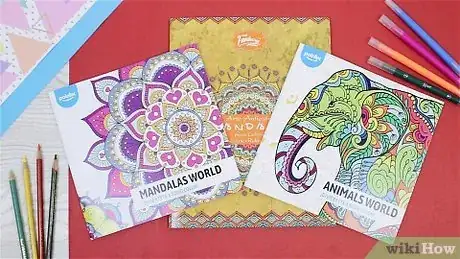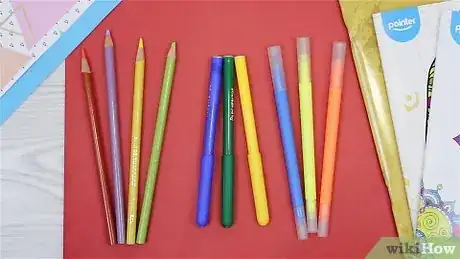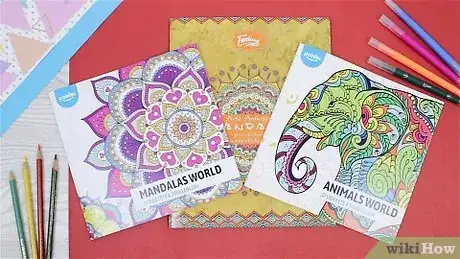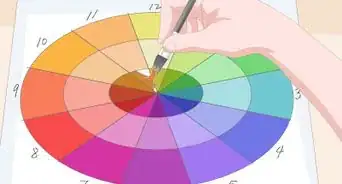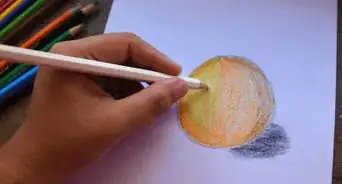This article was co-authored by wikiHow Staff. Our trained team of editors and researchers validate articles for accuracy and comprehensiveness. wikiHow's Content Management Team carefully monitors the work from our editorial staff to ensure that each article is backed by trusted research and meets our high quality standards.
The wikiHow Video Team also followed the article's instructions and verified that they work.
This article has been viewed 127,021 times.
Learn more...
Coloring books are fun for all ages. Although coloring is not generally considered to be very difficult, there are a number of methods and tips that you can use to help make your experience more enjoyable and successful.
Steps
Coloring for Kids
-
1Choose a coloring book that appeals to you. There are countless coloring books created specifically for kids, so finding one that suits your interests or mood should not be too difficult.
- You are not necessarily limited to actual coloring books. Tons of printable coloring pages are available online and many of them are free.[1]
-
2Select your coloring utensils. Crayons and water-based markers are both great for kids. Gel pens are another fun option.
- If you are using water-based markers that have become dried out, try reviving them by submerging the marker’s tip in warm water for roughly five seconds.[2]
Advertisement -
3Find a surface to color on. If you are using a loose leaf coloring page you will need to find a hard surface to work on, while coloring books allow you more flexibility.
- When using on loose sheets of paper, you may want to cover your work surface in newspaper depending on the coloring utensils you’ve chosen (markers may bleed through your paper and leave behind marks).
- When using coloring books, you can use your lap as a coloring surface if you’d like to draw while in bed on the couch, for example. You may still find it easier to have a more flat and solid surface to work on, though.
-
4Decide what colors you are going to use. For example, you might want to only use cool colors (blues, purples, and dark greens) or only use warm colors (reds, oranges, yellows, and light greens). Or, you might prefer to use all of the colors of the rainbow in your picture.
- Regardless of the colors you choose, having a rough idea of how you’d like your completed piece to look can help you create a picture you’re satisfied with.
-
5Choose the best place to begin coloring. Some drawing utensils (such as gel pens or markers) are more likely to smear than others.
- If you think your utensils could smudge, either color the center of your picture first and work your way outwards, or to start at the top of your page and work your way down.
- If you are not concerned about smudging, you can begin coloring wherever you’d like.
-
6Color along the lines first and work your way in. Coloring along the edges of a distinct area first and then working your way work way in will help prevent you from coloring outside of the lines.
- You may also find it helpful to filling in one distinct section completely before moving on to another section.
Coloring for Teens and Adults
-
1Choose a coloring book that appeals to you. Coloring books geared towards adults have enjoyed a recent surge in popularity, so you have many options to choose from.[3]
- Note that you are not necessarily limited to actual coloring books, as there are many printable coloring pages designed for adults are available online, many of which are free.
-
2Select your coloring utensils. Popular options include colored pencils, colored pens (e.g. Sharpie brand fine point markers), or art markers (Artist’s Loft Triangle Markers are a good cheap option, while Copic markers are a popular higher-end product).[4]
- If you are using pencils, be sure to sharpen them before you begin your coloring project, as this will allow you to have more precision in your coloring.
-
3Choose a surface to color on. If you are using a loose leaf coloring page you will want to find a hard surface to work on, while coloring books allow you more flexibility.
- When using on loose sheets of paper, you may want to cover your work surface in newspaper depending on the coloring utensils you’ve chosen (permanent markers, for example, may bleed through your paper and leave stains).
- When using coloring books, you can use your lap as a coloring surface if you’d like to draw while in bed on the couch, for example.
-
4Decide on a color scheme. You might, for example, choose to only use cool colors (blues, purples, and dark greens) or only use warm colors (reds, oranges, yellows, and light greens) for your project, or you may choose to mix many different hues together.
- No matter what colors you ultimately choose, having a rough idea of how you’d like your completed piece to look will help ensure that you are satisfied with your final product.
-
5Choose the best place to begin coloring. Some drawing utensils (such as gel pens, colored pens, or markers) are more likely to smear than others.
- If you think your utensils could cause unwanted smudging, it can be helpful either to color the center of your picture first and work your way outwards, or to start at the top of your page and work your way down.
- If you aren’t worried about smudging, begin coloring wherever you’d like.
-
6Color along the lines first and work your way in. Coloring along the edges of a distinct area first and then working your way work way in will help prevent you from coloring outside of the lines.
- You may also find it helpful to filling in one distinct section completely before moving on to another section.
-
7Use varying amounts of pressure to create the illusion of shadows. This technique, referred to as shading, adds depth and dimension to your picture. Simply vary the amount of pressure that you are apply with your coloring utensil depending on how light or dark you’d like a given area to be.
- Pressure shading is easiest to do with pencil.
- While shading is completely optional, creating depth or shadows in your picture can make it appear more realistic and detailed.
-
8Blend colors and shades to create dimension. Another way to add depth is to blend different shades or colors together to achieve different values.
- Example: if you want to create the appearance of shadow, try using a deeper blue (or red, or yellow, etc.) to create darker areas and a lighter blue for highlighted areas.
- This method can work with pencils, pens and markers.
-
9Vary your strokes to add depth to your drawing. Crosshatching is a popular and fairly simple way to create depth using variation in strokes. Crosshatching is done by drawing overlapping sets of lines at right angles (this pattern should look mesh-like). For darker areas, draw these lines closer together. To create highlights, leave more space between each line, or don’t draw any lines at all.
Community Q&A
-
QuestionHow do you motivate yourself to finish a page?
 VictoriaTop AnswererKeep telling yourself that it's going to look amazing when you're finished, and use only colors that you really like. If you keep doing this, you'll definitely get the motivation to finish a coloring page.
VictoriaTop AnswererKeep telling yourself that it's going to look amazing when you're finished, and use only colors that you really like. If you keep doing this, you'll definitely get the motivation to finish a coloring page. -
QuestionShould I color in the background when I'm finished?
 Community AnswerIt's up to you! Some people prefer to color in the background while others like to leave it blank. You should get creative with your coloring book!
Community AnswerIt's up to you! Some people prefer to color in the background while others like to leave it blank. You should get creative with your coloring book! -
QuestionHow to make skin look textured using colored pens/gel/pencil?
 Community AnswerTry mixing orange and white to get a skin color. Outline the edges of one side lightly with brown or a slightly darker shade to make it look more natural and to give definition.
Community AnswerTry mixing orange and white to get a skin color. Outline the edges of one side lightly with brown or a slightly darker shade to make it look more natural and to give definition.
Warnings
- Keep crayons away from small children, as they may try to eat the crayons.⧼thumbs_response⧽
Things You'll Need
- Coloring book or Internet pictures (Ink and a printer if you are using the images from the Internet)
- Crayons
- A little bit of coloring skill
References
- ↑ https://www.activityvillage.co.uk/colouring-pages
- ↑ http://www.crayola.com/faq/another-topic/how-can-i-revive-dry-crayola-markers-that-accidentally-were-left-with-their-caps-off/
- ↑ http://www.forbes.com/sites/kateharrison/2016/02/02/the-adult-coloring-craze-continues-and-there-is-no-end-in-sight/#68697105643b
- ↑ http://diycandy.com/2015/08/coloring-for-adults-101-your-complete-guide/
About This Article
To color in a coloring book, start by choosing a book you like and the coloring utensils you want to use, like crayons, markers, or colored pencils. Next, find a hard, flat surface to color on with plenty of room for you to spread out and get comfortable. Then, decide on a color scheme and begin coloring along the lines of the image before working your way in. Finally, use varying amounts of pressure to create the illusion of shadows and try blending colors to add dimension to your work! For tips on creating depth with your strokes, read on!
